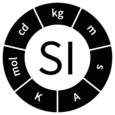SI derived unit
SI derived units are units of measurement derived from the seven base units specified by the International System of Units (SI). They are either dimensionless or can be expressed as a product of one or more of the base units, possibly scaled by an appropriate power of exponentiation.
The SI has special names for 22 of these derived units (for example, hertz, the SI unit of measurement of frequency), but the rest merely reflect their derivation: for example, the square metre (m2), the SI derived unit of area; and the kilogram per cubic metre (kg/m3 or kg m−3), the SI derived unit of density.
The names of SI derived units, when written in full, are in lowercase. However, the symbols for units named after persons are written with an uppercase initial letter. For example, the symbol for hertz is "Hz"; but the symbol for metre is "m".[1]
Derived units with special names
The International System of Units assigns special names to 22 derived units, which includes two dimensionless derived units, the radian (rad) and the steradian (sr).
Examples of derived quantities and units
Other units used with SI
Some other units such as the hour, litre, tonne, bar and electronvolt are not SI units, but are widely used in conjunction with SI units.
Supplementary units
Until 1995, the SI classified the radian and the steradian as supplementary units, but this designation was abandoned and the units were grouped as derived units.[3]
See also
- International System of Quantities (ISQ)
- International Vocabulary of Metrology
- Metric prefix
- Metric system
- Planck units
References
- ^ Suplee, Curt (2 July 2009). "Special Publication 811".
- ^ International Bureau of Weights and Measures (2006), The International System of Units (SI) (PDF) (8th ed.), ISBN 92-822-2213-6, archived (PDF) from the original on 4 June 2021, retrieved 16 December 2021
- ^ "Resolution 8 of the CGPM at its 20th Meeting (1995)". Bureau International des Poids et Mesures. Retrieved 23 September 2014.
Bibliography
- I. Mills, Tomislav Cvitas, Klaus Homann, Nikola Kallay, IUPAC (June 1993). Quantities, Units and Symbols in Physical Chemistry (2nd ed.). Blackwell Science Inc. p. 72.
{{cite book}}: CS1 maint: multiple names: authors list (link)

